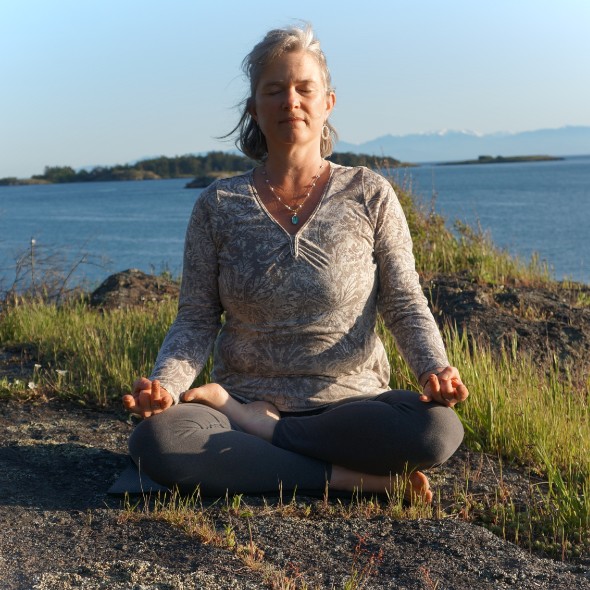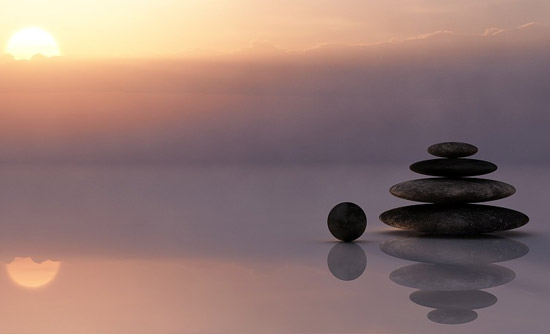
Inspiring Gratitude: A Meditation and Yoga Asana Practice
Recite out loud and contemplate: Dew drops on a blade of grass, having so little time before the sun rises; Let not the autumn wind blow so quickly on the field ~Zen Master Dogen Even after all this time, The sun never says to the earth, “You owe me” Look what happens with a love like that It lights the whole sky. ~Hafiz of Persia 1.) Sit quietly, feel the foundation of the earth below you. Balance evenly on that support. Breathe softly and gently through the nose. Lift your spine tall on the inhale and open your heart center. Softly release any tensions away on the exhale, root yourself to the earth. As you sit, let your heart fill with gratitude for this moment. 2.) Feel the support of the earth underneath you. Inhale, open your chest and lift your hips. Gently lift the chin and bring a soft gaze to your eyes, relax your busy mind. Exhale, reach your hips back towards your heels, Pause movement and breath half way down, hear the silence there, and surrender to this moment. Then release back fully to the heels and rest your head. Inhale back up to all fours and lift your heart, be open to all possibilities……. Back and forth like a wave, open and receive on the inhale, release and let go on the exhale. 3.) Feel the ground solid under your feet supporting you, rest your hands over your heart center. Inhale into bridge as you open the arms out to the side in a gesture of acceptance. Lift your heart center and let it fill with appreciation for who you are. Exhale and slowly curl back down, arms gently returning back to your heart center, rest in the comfortable place that is you. 4.) Stay here breathing softly, supported by the bolster let your heart center open to the Divine Light flowing as prana within us and all around us. Breathe softer, dwelling in the pauses on each side of the breath, becoming more present with this awareness. Let go of expectations and worries. Feel your heart center to radiating like the sun, lighting up the whole sky, expecting nothing in return. Breathe into this….. 5.) Lay on your back, put a strap over your foot, extend the leg up on your inhale and open the bottom of your foot to the sky. Exhale and ground your pelvis to the earth. Hold the strap in one hand and on your next inhale open the leg out to the side, and find your edges of mobility while you keep your pelvis stable. Exhale again and bring your leg back to center. Repeat this movement exploring where you can maintain steadiness and centeredness in body, breath and mind. After a few times finally let your leg rest out to the side on blankets under the outer hip. Relax the shoulders and neck as you gently hold the strap. Stay here for a few breaths, explore the very root of your being. Give gratitude for your ancestors. 6.) Sit wide legged, lay your front spine down comfortably on the bolster. Have your entire front body open and supported by the bolster. Every exhalation feel your spine resting more deeply like a vine to a trellis. Breathe soft and subtle through the nose. Quiet the eyes and your entire face. Release your fears and doubts with every exhale. Nourish yourself with every inhale. Create a safe place to fill your heart with gratitude for your life. 7.) Now rest back for several rounds of breath on the bolster in bound angle pose. Bring the bottoms of the feet together and relax your hips and head support. Relax in service to yourself; to restore and renew your body and your mind. Touch into your heart center, let the rhythm of the breath inspire compassion and Love within you. Every moment is like a drop of dew on the blade of grass. Temporary. Ever changing. Ebb and flow with each moment. Just as your breath comes and goes. Appreciate this moment for whatever it is. 8.) Lie comfortably in savasana. Make sure you are warm and supported. Soften your body from your head to your toes, release away tension on your exhales. Drop back into a quiet space, become quieter and quieter with every breath. In corpse pose, embrace the truth of impermanence and the preciousness of every moment. With each breath bring in gratitude for your body, your mind, your breath, your heart, this moment……. See yourself filling with Divine Light. Let gratitude radiate within you for who you are, just as you are right now. Surrender to the support of the earth underneath you, to the sweet soft air moving in and out of you, and to the vibration of your heart center vibrating with the sun. Open your inner ears to that vibration, listen to the truth that speaks your inner wisdom. Over and over again as you breathe let waves of gratitude wash over you. In every fleeting moment. Rest in the unconditional Love that surrounds you. Namaste. Gratitude turns what we have into enough, and more. It turns denial into acceptance, chaos into order, confusion into clarity…. it makes sense of our past, brings peace for today, and creates visions for tomorrow

